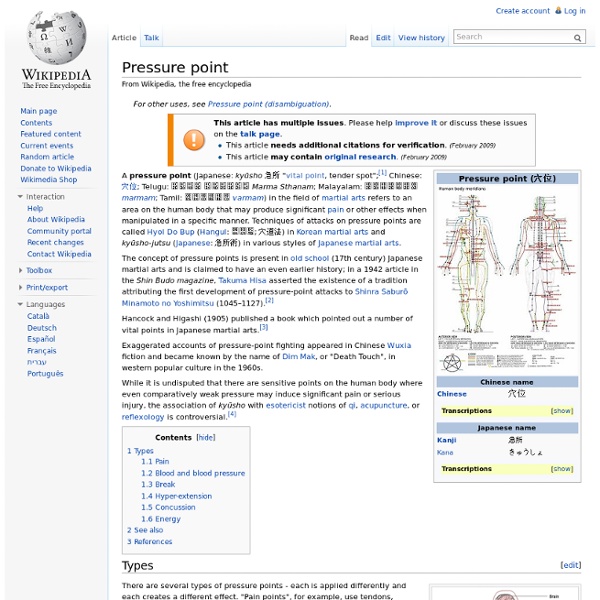Zoom
Trash
Related:



Defendu Defendu is a modern martial art developed by William E. Fairbairn and Eric A. Sykes prior to World War II. Development[edit] Based on his training in boxing, wrestling, savate, early Judo at the Kodokan in Tokyo, and fights he was involved in during his police work, Fairbairn began to develop his own system of hand to hand combat, calling it "Defendu". Fairbairn was called upon by the British to help train Allied troops in World War II. The original Defendu was oriented towards self-defense and restraint, while the Close Quarters Combat system concentrated on rapid disabling of an opponent, with potentially lethal force. Fairbairn published several more books on the subject of self-defense, all of which refer to Defendu only in relation to the earlier book. World War II[edit] The start of the Second World War saw the Allied forces needing every advantage to give their soldiers and special forces a winning edge. Post war[edit] See also[edit] World War II combatives References[edit]
Southern Dragon Kung Fu The movements of the Southern Dragon style (Chinese: 龍形摩橋; pinyin: lóng xíng mó qiáo; Cantonese Yale: long4 ying4 mo1 kiu4; literally "dragon shape rubbing bridges") of Shaolin Boxing are based on the mythical Chinese dragon. The Dragon style is an imitative-style that was developed based on the imagined characteristics of the mythical Chinese dragon. The Dragon played an influential and beneficial role in Chinese culture. The dragon represented two of the ancient elements, Earth and Water, endowing the creature with powers of illusion and strength. History[edit] The history of Southern Dragon style has historically been transmitted orally rather than by text, so its origins will probably never be known in their entirety. Southern Dragon style has roots in Hakka Kuen, a combination of the local styles of the Hakka heartland in inland eastern Guangdong with the style that the monk Ji Sin Sim Si taught in Guangdong and the neighboring province of Fujian in the 18th century.[1] Basics[edit]
Martial arts The martial art of boxing was practiced in the ancient Thera. Martial arts are codified systems and traditions of combat practices, which are practiced for a variety of reasons: self-defense, competition, physical health and fitness, entertainment, as well as mental, physical, and spiritual development. Variation and scope[edit] Martial arts may be categorized along a variety of criteria, including: By technical focus[edit] Unarmed Grappling Weapon-based Those traditional martial arts which train armed combat often encompass a wide spectrum of melee weapons, including bladed weapons and polearms. Sometimes, training with one specific weapon will be considered a style of martial arts in its own right, which is especially the case in Japanese martial arts with disciplines such as kenjutsu and kendo (sword), bojutsu (staff), and kyudo (archery). By application or intent[edit] Combat-oriented Health-oriented Spirituality-oriented Martial arts can also be linked with religion and spirituality.
Jeet Kune Do Jeet Kune Do, also Jeet Kun Do, and abbreviated JKD, is an eclectic and hybrid martial art system and philosophy of life founded by the martial artist Bruce Lee[2] (1940-1973) 1960 with simple and direct, or straightforward, movements and non-classical style. Jeet Kune Do practitioners believe in minimal movements with maximum effects and extreme speed. The system works by using different "tools" for different situations, where the situations are divided into ranges, which is kicking, punching, trapping, and grappling, where we use techniques to flow smoothly between them. It is referred to as "a style without style" or "the art of fighting without fighting" as said by Lee himself. Unlike more traditional martial arts, Jeet Kune Do is not fixed or patterned, and is a philosophy with guiding thoughts. It was named for the concept of interception or attacking while one's opponent is about to attack. System and philosophy[edit] Lee's philosophy[edit] Principles[edit] Straight lead[edit]
Jujutsu Jujutsu (/dʒuːˈdʒuːtsuː/; Japanese: 柔術, jūjutsu listen , Japanese pronunciation: [ˈdʑɯɯ.dʑɯ.tsɯ]) is a Japanese martial art and a method of close combat for defeating an armed and armored opponent in which one uses no weapon or only a short weapon.[1][2] The word jujutsu can be spelled as ju-jitsu/jujitsu, ju-jutsu. "Jū" can be translated to mean "gentle, soft, supple, flexible, pliable, or yielding." "Jutsu" can be translated to mean "art" or "technique" and represents manipulating the opponent's force against himself rather than confronting it with one's own force.[1] Jujutsu developed among the samurai of feudal Japan as a method for defeating an armed and armored opponent in which one uses no weapon, or only a short weapon.[3] Because striking against an armored opponent proved ineffective, practitioners learned that the most efficient methods for neutralizing an enemy took the form of pins, joint locks, and throws. History[edit] Origins[edit] Development[edit] Description[edit]